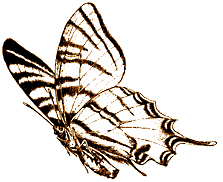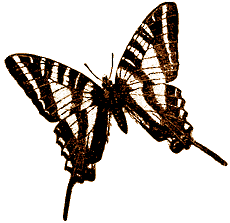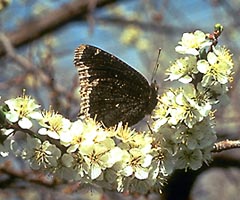
|
We can learn much about butterfly gardening by examining the life history of some specific butterflies. More details on caterpillar host plants of common butterflies found, for instance, in Minnesota are given in Table 2.
Black Swallowtail (Papilio polyxenes) caterpillars feed on dill, parsley and a few related species in the plant family Umbelliferae. Their larvae accumulate toxins from the host in their body and these chemicals can be found in the adult butterfly as well. Caterpillars and adults are strikingly colored as a way to advertise their toxicity and distastefulness to birds.

|
Some butterflies have only one generation a year. The pupa overwinters and the butterfly emerges in the spring. Only a few, such as Mourning Cloaks (Nymphalis antiopa) over winter as adults. Mourning Cloaks are the first butterflies seen in the spring, feeding on nectar from shrubs such as Amelanchier. Their caterpillars feed on a variety of common trees, such as willows, poplars and elm. They overwinter in barns, tree holes or other protected areas.
 |
 |

|
The American Painted Lady (Vanessa virginiensis) and the Painted Lady (Vanessa cardui) do not overwinter in Minnesota but migrate from the south in the spring. Painted ladies are attracted to open areas with low vegetation and a variety of flowers. The larvae feed on everlastings (Anaphalis spp. ) as well as thistles. The adults prefer pussytoes (Antennaria spp.) and other composites, such as black-eyed Susan and sunflowers.
The Monarch (Danaus plexippus) migrates south for the winter. After overwintering in the highlands of Mexico, the overwintering generation flies north to the latitude of Texas and lays eggs. These eggs hatch and the larvae feed. The pupae turn into adult monarchs in 10 to 14 days, and it's this generation that arrives in Minnesota in May and June. During the summer, the migrant adults lay eggs that produce the generation of monarchs that return to Mexico in the fall.
Back to "Creating a Butterfly Garden"
| Butterfly Species | Caterpillar Food Plant |
| Swallowtail Family (Papilionidae) | |
| Black Swallowtail | Parsley family - both wild and cultivated: carrot, dill, parsley, and parsnip |
| Spicebush Swallowtail | Spicebush, sassafras |
| Tiger Swallowtail | Aspen, cherry, birch |
| Snout Butterfly (Libytheidae) | |
| Common Snout Butterfly | Hackberry |
| Brush-footed Family (Nymphalidae) | |
| Great Spangled and Idalia Fritillary | Violets |
| Buckeye | Plantains, gerardias, toadflax, snapdragons, false loosestrifes |
| Painted Lady | Thistles |
| Red Admiral | Nettles, false nettle |
| Viceroy and Red-Spotted Purple | Willows, especially black willow, pussy willow, poplars, plums, cherries |
| Hackberry Butterfly | Hackberry |
| Monarch Butterfly | Milkweeds, butterfly weed |
| Mourning Cloak | Willow, birch, aspen, maple, elm |
| Sulphur Family (Pieridae) | |
| Common (clouded) Sulphur | Clover, alfalfa |
| Dogface Butterfly | Lead plant, false indigo, prairie clover |
| Coppers, Blues, Harvesters, Metalmarks Families (Lycaenidae, Riodinidae) | |
| American Copper | Sorrel |
| Sylvan Hairstreak | Willow |
| Common Hairstreak | Mallow family, rose & marsh mallows, hollyhock |
| Gray Hairstreak | Hawthorn |
| Skipper Family (Hesperidae) | |
| Blazing Star Skipper | Grasses |
|
James Ford Bell Museum of Natural History. Used with permission. | |
 In the left illustration, “A” is an adult butterfly nectar feeding. “B” shows females ovipositing (egg-laying). “C” represents several instars, or stages, of larval feeding and growth. “D” is the pupa (chrysalis of a butterfly). “E” is a newly emerged butterfly adult drying its wings. |
 In the bottom illustration, of moths, “A” is an adult resting with its wings folded. “B” and “C” represent two larval instars. “D” is the hairy cocoon of the moth. |
|
|
Behaviors to Watch |
|
|
Back to Table of Contents |